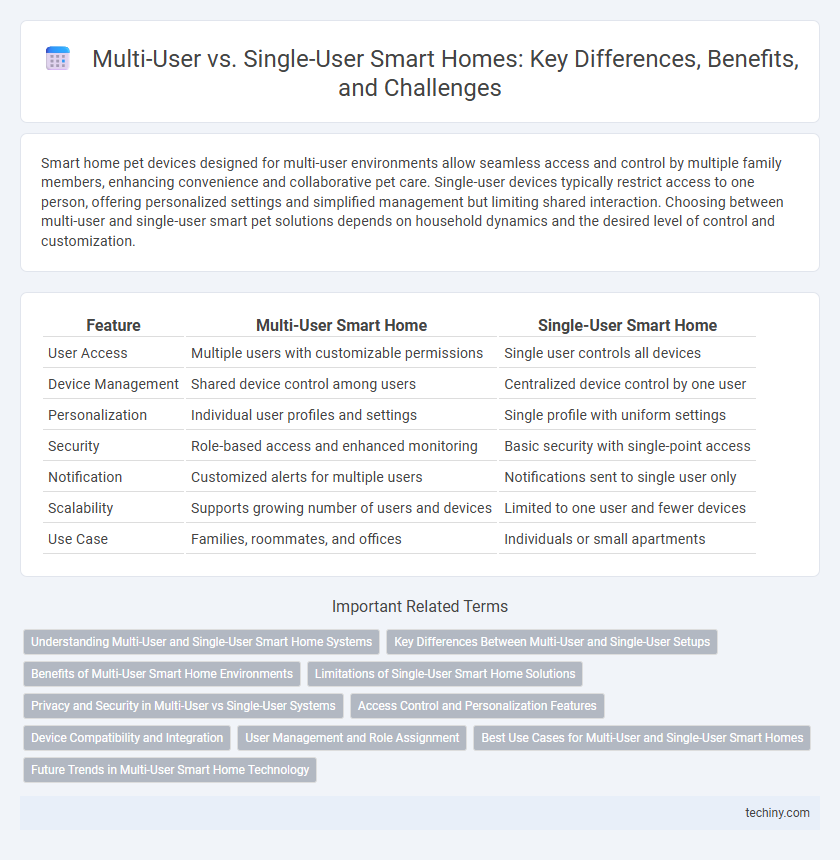Smart home pet devices designed for multi-user environments allow seamless access and control by multiple family members, enhancing convenience and collaborative pet care. Single-user devices typically restrict access to one person, offering personalized settings and simplified management but limiting shared interaction. Choosing between multi-user and single-user smart pet solutions depends on household dynamics and the desired level of control and customization.
Table of Comparison
| Feature | Multi-User Smart Home | Single-User Smart Home |
|---|---|---|
| User Access | Multiple users with customizable permissions | Single user controls all devices |
| Device Management | Shared device control among users | Centralized device control by one user |
| Personalization | Individual user profiles and settings | Single profile with uniform settings |
| Security | Role-based access and enhanced monitoring | Basic security with single-point access |
| Notification | Customized alerts for multiple users | Notifications sent to single user only |
| Scalability | Supports growing number of users and devices | Limited to one user and fewer devices |
| Use Case | Families, roommates, and offices | Individuals or small apartments |
Understanding Multi-User and Single-User Smart Home Systems
Multi-user smart home systems enable personalized settings for each user, enhancing convenience and security by recognizing individual preferences and access levels through user profiles. Single-user smart home systems focus on centralized control, typically managed by one person, simplifying device management but limiting customization for multiple occupants. Understanding these differences helps homeowners choose systems that best fit their household dynamics and technology needs.
Key Differences Between Multi-User and Single-User Setups
Multi-user smart home setups enable multiple family members or residents to control devices independently via personalized profiles, enhancing security and convenience. Single-user configurations typically centralize control to one person, which can limit accessibility but simplify management and reduce potential conflicts. Key differences include user access levels, customization options, and overall system scalability tailored to household dynamics.
Benefits of Multi-User Smart Home Environments
Multi-user smart home environments enhance convenience by allowing personalized settings for lighting, temperature, and security accessible to all residents. These systems improve security through individual access controls and activity monitoring, reducing risks associated with shared credentials. Energy efficiency is optimized as usage patterns from multiple users inform smarter automation and resource management.
Limitations of Single-User Smart Home Solutions
Single-user smart home solutions often face limitations in accommodating diverse preferences and schedules within a household, leading to reduced overall efficiency and user satisfaction. These systems typically lack advanced personalization features and multi-profile support, restricting seamless automation for different family members. Consequently, they fall short in delivering an inclusive smart home experience that adapts dynamically to multiple users' needs.
Privacy and Security in Multi-User vs Single-User Systems
Multi-user smart home systems present increased privacy risks due to multiple access points, requiring robust authentication and user-specific permissions to prevent unauthorized data access. Single-user systems offer simpler security management but may lack granularity in controlling device interactions and data sharing. Advanced encryption and secure user profiles are essential in multi-user setups to maintain privacy and ensure secure device communication across diverse household members.
Access Control and Personalization Features
Multi-user smart home systems offer advanced access control by enabling role-based permissions and customized entry codes, enhancing security for families or shared spaces. Personalization features adapt lighting, temperature, and device preferences to individual users, improving comfort and convenience. Single-user systems simplify management but lack nuanced access restrictions and tailored experiences essential for multi-occupant environments.
Device Compatibility and Integration
Multi-user smart home systems offer broader device compatibility, supporting multiple user profiles for personalized settings across diverse devices from various manufacturers. Single-user setups typically have limited integration options, focusing on ease of use for one person which can restrict compatibility with multi-brand ecosystems. Choosing multi-user platforms enhances seamless device synchronization and centralized control, optimizing smart home functionality for all household members.
User Management and Role Assignment
Multi-user smart home systems enable efficient user management by allowing the assignment of specific roles and permissions based on individual access needs, enhancing security and personalized control. Single-user setups often limit functionality to one primary account, reducing flexibility in control and access delegation across multiple household members. Implementing robust role assignment in multi-user environments ensures seamless operation and tailored user experiences within the smart home ecosystem.
Best Use Cases for Multi-User and Single-User Smart Homes
Multi-user smart homes excel in environments with multiple family members or roommates, offering personalized automation like individual lighting, climate preferences, and access controls. Single-user smart homes are ideal for individuals seeking streamlined control and simplified setup, focusing on personal routines such as automated morning alarms and security monitoring. Multi-user systems maximize customization and security in shared spaces, while single-user setups prioritize ease of use and efficiency for solo occupants.
Future Trends in Multi-User Smart Home Technology
Future trends in multi-user smart home technology emphasize personalized user experiences through advanced AI algorithms that recognize individual preferences and behaviors. Enhanced security protocols incorporating biometric authentication and multi-factor verification will ensure safe access for multiple residents. Integration of seamless voice control across different users and devices will drive convenience and efficiency in shared smart environments.
Multi-User vs Single-User Infographic

 techiny.com
techiny.com